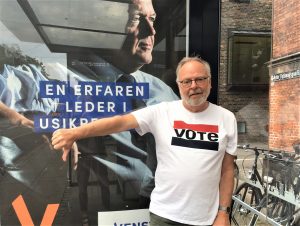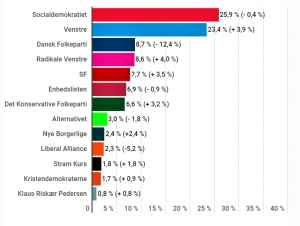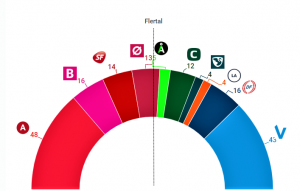
RED PARTIES WIN DANISH ELECTION
Let us start with the photograph at the top: This is the closest encounter I have had during four weeks of campaigning with the person likely to be the new Danish Prime Minister, Mette Frederiksen, from the Social Democratic Party. It was taken at a bus stop in Copenhagen, close to the voting station I attended to cast my vote on the morning of election day on June 5. By the way, June 5 also happens to be Constitution Day in Denmark. This is the day we celebrate our democracy – including the ability of the political parties in parliament to agree on long-term legislation in a peaceful and consensus-oriented manner. With a system of proportional representation and a low threshold of 2% to win seats, there are normally a large number of parties represented and never one party able to command a majority.

At the same bus stop, I also had the opportunity to say hello to the Prime Minister the Danes elected four years ago on 18 June 2015, Lars Løkke Rasmussen, the leader of the Liberal Party. As indicated by the thumb of my hand, I did not vote for him or any other party belonging to the blue bloc. To be honest, I have never voted for a party to the right of the centrist Social Liberal Party, which considers itself to belong to what we somewhat inaccurately term the red bloc of political parties, although some of its economic policies are closer to blue bloc.
Following the counting of the personal votes on June 6 [and this means manually counting the paper ballots that we continue to use in our elections, because we do not fully trust that an internet-based voting system cannot be manipulated more easily than the present counting by volunteers from all political parties], the Danish parliament, Folketinget, will have its 175 seats divided among the following parties [to explain the numbers: total membership is 179, with the last 4 seats belonging to the Faroe Islands and Greenland, with 2 seats each]:


As witnessed by the graphic presentations above of percentages and seats, the result basically means that there is a majority of 52,1% for the red bloc of five parties including the Alternative – with a total of 96 seats. It takes 90 seats to form a majority! On the other side, the four parties of the blue bloc command only 47,9% and 79 seats. This is as clear a majority as some of the surveys undertaken over the last four weeks tended to indicate would be the case. In our political system it is a strong victory! And many commentators have characterized it as a green victory, because all the red bloc parties have run campaigns arguing for a much more ambitious green plan for Denmark. It looks like the Danes have received this message favorably.
So far so good! But it will not at all be an easy task for the Social Democratic leader, Mette Frederiksen, to form a sustainable and stable government. Her idea, as stated throughout the campaign and repeated in the final discussion among party leaders right after midnight, is to form a Social Democratic minority government. This will be a government trying to form different majority coalitions on different issues – different on immigration and integration, different on climate, different on welfare issues, etc. This has been tried before in Denmark, but has mostly been very difficult, with governments not lasting the full four-year term. In any case, negotiations among red bloc parties could take a long time, just like it was the case back in 2011, when the Social Democrats last came to power.
So rather than speculate on how exactly the next government will look like, I will quickly run through the results of the parties and try to explain why [in my humble view] they have won, lost or maintained their position and number of seats in parliament.

First, I will mention the five parties belonging to the RED BLOC, and they will be presented in order of their strength in the new parliament. Of course, my assessment is colored by my own political thinking:
Social Democrats [25,9%] 48 seats: The result is slightly less in percentage terms than the 2015 result, but actually with one more seat due to technicalities. Four years ago, the then Prime Minister, Helle Thorning-Schmidt, lost narrowly to Lars Løkke Rasmussen and the Liberal Party, following a rather weak performance of the three-party government of Social Democrats, Social Liberals and Socialist People’s Party during 2011-2015. The new party leader, Mette Frederiksen, has moved the party towards the right on issues of refugees and immigration, and this is one reason for the popularity of the party leader. At the same time, the party has focused on more resources for the health sector, for children, for the elderly, and for education. The party has also criticized the blue government for not being ambitious enough on the climate agenda. Although she did not win more votes for her party, Mette Frederiksen could be seen as one of several victorious party leaders, since she is likely to be Prime Minister.
Social Liberal Party [8,6%] 16 seats: The party is undoubtedly one of the large victors, doubling number of votes and seats. This will provide the party leader Morten Østergaard with a strong platform in negotiations with the Social Democrats. Historically, the Social Liberals have also cooperated closely with parties in the blue bloc, even as member of a blue government. Because of the somewhat love-hate-relationship between Social Liberals and Social Democrats, negotiations can be extremely interesting.
Socialist People’s Party [7,7%] 14 seats: This is another victorious party, under the leadership of Pia Olsen Dyhr, also doubling the number of seats in parliament. It is particularly impressive because the party imploded after having been part of the government 2011-15 and then had to change its leadership. The green agenda has been at the forefront, as well as welfare issues related to the plight of children, the rising number of poor children in Denmark.
Red-Green Alliance [6,9%] 13 seats: This is a loss of 1 seat compared to 2015, when the party had a very successful election. Still, I am sure the loss came as a surprise, not least because according to most commentators the party presented a strong plan for what Denmark needs to do on climate change and other issues of the environment. It has been consistently critical of the tough approach taken by the present government on refugees and immigrants, and this is a critique the party has also directed towards the Social Democrats.
Alternative [3%] 5 seats: A loss of one seat. The party came into parliament for the first time in 2015 with great enthusiasm and far more seats than expected. It has been the party that argued most strongly for a more ambitious green agenda, and for a different approach to political discussions, with political ‘enemies’ listening more to their opponents. Maybe one explanation is that the green agenda is now shared by all parties in the red bloc; another could be that the leadership of the party has at times been somewhat erratic. It could also be a factor that the party did not want to commit itself to support the Social Democratic leader as the next Prime Minister, and presenting party leader Uffe Elbæk as a candidate for the position – which most voters probably considered more as a joke than anything else.

Then, I will mention the four parties belonging to the BLUE BLOC, and they will be presented in order of their strength in the new parliament:
Liberal Party [23,4%] 43 seats: Despite the blue bloc parties as a whole losing the election, the party of Prime Minister Lars Løkke Rasmussen managed to win more additional seats than any other party, thus inching closer to the Social Democrats as the second largest party. For several years, the party has been discussion who should be the next party leader, but with this win, it is likely that those inside the party wishing to challenge the former Prime Minister have been silenced. In the last part of the election campaign, the PM argued for a new government across the centre, meaning the Liberal Party and the Social Democrats. While not everything in politics can be predicted, I believe this idea was dead upon arrival. And with the historic majority for the red bloc parties, it is hard to imagine that such an option is feasible.
Danish People’s Party [8,7%] 16 seats: This right-wing anti-immigration party has for many years played a key role in Danish politics, despite never being in government. This has come to a full stop in the 2019 election. Never in the history of Danish party politics has a party lost this big – down to 16 seats from the 37 seats won in 2015. Despite this, chairman Kristian Thulesen Dahl has so far decided not to step down, but rather argued that “the skipper of the boat should remain, when the boat is sailing in difficult waters”. There is probably no one reason for the total collapse, but the strategy of the Social Democrats to move to the right on refugees and immigration is likely to have been one of the key reasons.
Conservative People’s Party [6,6%] 12 seats: In addition to the Liberal Party, the Conservatives also gained seats, regaining political strength after several elections of losses. This time the number of seats doubled, and this could be seen as a recognition of the strategy of party leader Søren Pape Poulsen. It could also be seen as an acceptance, finally, of his leadership of a party that has been through several changes of leader.
Liberal Alliance [2,3%] 4 seats: In this election, the party met the wall, losing nine of the 13 seats won in 2015. A total meltdown. Party leader Anders Samuelsen, who has been the Minister of Foreign Affairs in the Liberal Party-led government, decided to withdraw as leader of the party the next day, and the new leader will be decided by the four members of parliament left. Again, there is probably more than one reason for the dramatic defeat, but many would point to the historical fact that most small parties joining a government tend to lose more than the leading coalition party.
New Bourgeois Party [2,4%] 4 seats: This is one of the four new parties participating in the 2019 election. It could be placed to the right of the Danish People’s Party, with extreme positions on immigration and integration, including a willingness to break some of the international conventions that Denmark has signed. During the campaign, most parties of both red and blue bloc made it clear that they would not base a government or any agreement on the votes of this party.
Finally, three parties did not manage to climb above the two percent threshold. The Christian Democrats [1,7%] came very close to winning a district mandate, but at the end of election night they were a few hundred votes short. The extremely right-wing party Extreme Direction [1,8%] also came close, receiving 60.000 votes for its Muslim-bashing agenda with a proposal to deport hundreds of thousands of Muslims. The last party, the Klaus Riskær Pedersen Party [0,8%], founded by a person who has a history representing the Liberal Party, never came off the ground.

The photo above tells the story about three party leaders from Socialist People’s Party, Social Liberal Party and Social Democrats having a relaxed time when they met the press in the Press Club on 6 June. Today, on 7 June, the Social Democratic leader has started her effort to find a programmatic platform, which is strong enough for a government with her as Prime Minister to survive a vote of no-confidence in Parliament. We will have to wait several days, if not several weeks, before we know the outcome. When it is there, I will inform you about it.
